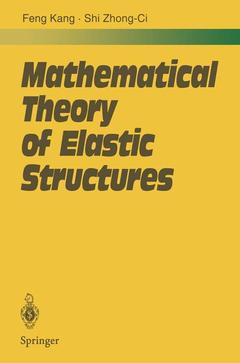Description
Mathematical Theory of Elastic Structures, Softcover reprint of the original 1st ed. 1996
Authors: Feng Kang, Shi Zhong-Ci
Language: French
Subject for Mathematical Theory of Elastic Structures:
Approximative price 52.74 €
In Print (Delivery period: 15 days).
Add to cart
Publication date: 10-2013
395 p. · 15.5x23.5 cm · Paperback
395 p. · 15.5x23.5 cm · Paperback
Description
/li>Contents
/li>
Elasticity theory is a classical discipline. The mathematical theory of elasticity in mechanics, especially the linearized theory, is quite mature, and is one of the foundations of several engineering sciences. In the last twenty years, there has been significant progress in several areas closely related to this classical field, this applies in particular to the following two areas. First, progress has been made in numerical methods, especially the development of the finite element method. The finite element method, which was independently created and developed in different ways by sci entists both in China and in the West, is a kind of systematic and modern numerical method for solving partial differential equations, especially el liptic equations. Experience has shown that the finite element method is efficient enough to solve problems in an extremely wide range of applica tions of elastic mechanics. In particular, the finite element method is very suitable for highly complicated problems. One of the authors (Feng) of this book had the good fortune to participate in the work of creating and establishing the theoretical basis of the finite element method. He thought in the early sixties that the method could be used to solve computational problems of solid mechanics by computers. Later practice justified and still continues to justify this point of view. The authors believe that it is now time to include the finite element method as an important part of the content of a textbook of modern elastic mechanics.
1 Simple Modes of Elastic Deformation.- 2 Static Elasticity.- 3 Typical Problems of Elastic Equilibrium.- 4 Composite Elastic Structures.- 5 Finite Element Methods.- References.
© 2024 LAVOISIER S.A.S.
These books may interest you

Finite Elements Methods in Mechanics 105.49 €

Finite Elements Methods in Mechanics 105.49 €


